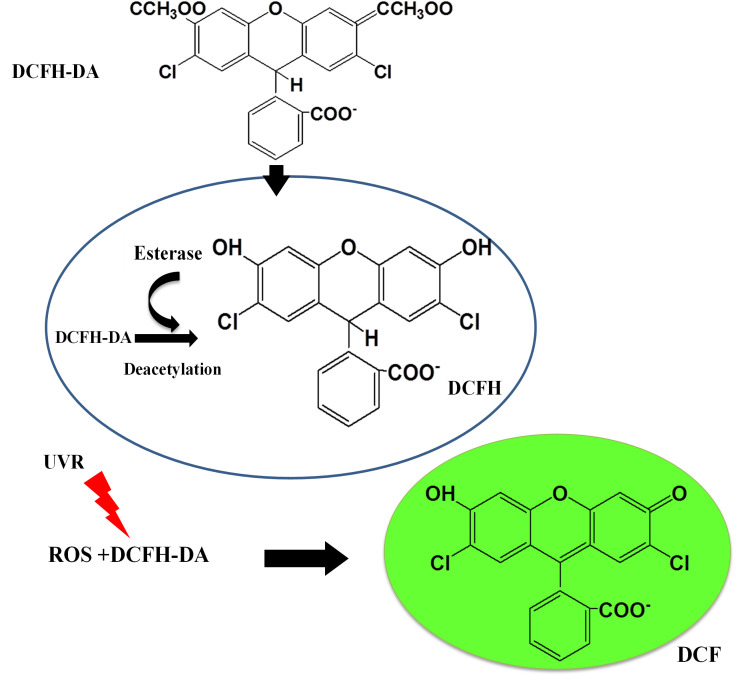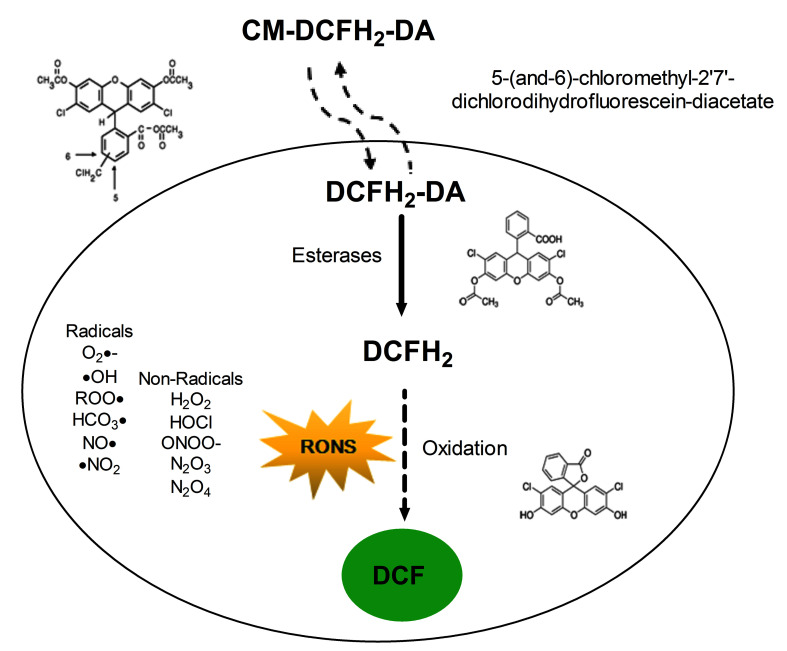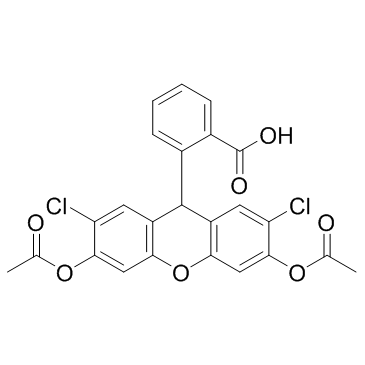H2DCFDA (DCFH-DA)
H2DCFDA or DCFH-DA is the short form, which is used for 2',7'-dichlorodihydrofluorescein diacetate. Its molecular structure is diagrammatically depicted in Figure 1. It is neutral as it does not carry a net electric charge, thus it is non polar also.

Figure 1 The Molecular Structure of 2',7'-dichlorodihydrofluorescein diacetate, which is also known as H2DCFDA or DCFH-DA
It can be used as a stain/ probe in quantifying the oxidative stress of the cells (adherent as well as suspended; the protocol is a little bit changed for suspended cells) in terms of Reactive Oxygen Species, which are primarily short lived (Oparka et al.). Reactive Oxygen Species ROS is majorly produced in the mitochondria. Chemically, Reactive Oxygen Species ROS are the derivatives of oxygen and oxidizing in nature, that means they has the ability to cause oxidation of their substrate molecule (de Haan et al., 2022). Thus, they are regarded as oxidants (Reiniers et al., 2021). They include the superoxide ions and hydroxyl ions which are primarily free radicals of oxygen in nature; and, also hydrogen per oxide which is not a free radical of oxygen but a molecule (Szychowski et al., 2016).
In fact, using it is not only a cost effective but also a very simple, sensitive, economic (Eruslanov and Kusmartsev, 2010), easy (Yoon et al., 2018), reliable, rapid (Rajneesh et al., 2017) and efficient protocol to estimate oxidative stress. Measuring Reactive Oxygen Species (Oparka et al.) is quite useful across a broad spectrum of experimental settings, especially where oxidative stress is the dependent variable against any valid independent variable like environmental, i.e., heat (Yoon et al., 2018) or ultraviolet light (Rajneesh et al., 2017), chemical or genetic factors; as the oxidative stress is equally important parameter in normal physiology and abnormal various pathologies, for example, cancer, metabolic diseases like diabetes, inflammatory diseases, neurogenerative diseases (de Haan et al., 2022) and the liver pathologies as liver is the hub of mitochondria and those enzymes which produce ROS and its role in the metabolism of copper and iron (Reiniers et al., 2021). In normal physiology, low levels of ROS are present as they are produced during the metabolism, specifically aerobic one. These are important as they act a signaling molecules under normal conditions for many vital biochemical pathways. Moreover, redox homeostasis is also maintained. On the other hand, in pathologies, abnormally high level of ROS which is harmful for the structural and functional macromolecules and thus lethal to the cells, for example, proteins, lipids and DNA (Oparka et al., 2016). More specifically, these harmful effects are; proteins get denatured, lipids get peroxidized and DNA gets mutated (Yoon et al., 2018). Moreover, these effects are irreversible that means these cannot be rectified or nullified by the cell in any case (de Haan et al., 2022), and eventually leads to apoptosis/ cell suicide, which is a type of programmed cell death (Dornas and Schuppan, 2021). Thus, the role of 2',7'-dichlorodihydrofluorescein diacetate (DCFH-DA) is important in any pathology where some kind of oxidative stress is involved. Due to all of the above-mentioned factors, using 2',7'-dichlorodihydrofluorescein diacetate (DCFH-DA) is in fact the most popular approach to quantify the oxidative stress and ROS (Szychowski et al., 2016).
The underlying mechanism involves the entry of 2',7'-dichlorodihydrofluorescein diacetate (DCFH-DA) into the cell, where esterase enzyme eliminates the acetyl group, i.e., deacetylation, (Yoon et al., 2018) and converts it into DCFH. DCFH cannot escape the cell as it is impermeable to cell membrane (Eruslanov and Kusmartsev, 2010). This DCFH gets oxidized by ROS into the final product, i.e., 2’-7’dichlorofluorescein (DCF). This final product is fluorophore, that means it emits visible light upon excitation with a particular wavelength of light; it emits a green light of 530 nm when excited with a light of 485 nm. Moreover, its fluorescence is directly proportional to the amount of oxidative stress. Thus, the presence of this fluorophore quantitatively represents the ROS, which can be estimated via using a fluorescence microscope (Kim and Xue, 2020). All the molecular events involved are diagrammatically illustrated in Figure 2.

Figure 2 Molecular Events involved in the conversion of 2',7'-dichlorodihydrofluorescein diacetate (DCFH-DA)(non-polar in nature) into the 2’-7’dichlorofluorescein (DCF) which is fluorophore in nature having green light emission, thus written in green via an intermediate molecule, i.e., DCFH or DCFH2 (polar in nature) in the cell as 2',7'-dichlorodihydrofluorescein diacetate (DCFH-DA) enters the cell as molecular probe for detecting the Reactive Oxygen Species ROS
DCFH2 or DCFH reacts with different Reactive Oxygen Species ROS in the cell, so it is a generic instead of being a specific molecular probe. To name a few, nitrogen dioxide, carbonate radical anion, hydroxyl radical, thiyl radicals, cytochrome c peroxidase, iron with oxidation state +2 and copper with oxidation state +1 are the prominent ROS. Therefore, the measured oxidative stress is also non-specific in nature, that means it can never be estimated that which ionic species is responsible for this measured oxidative stress (Reiniers et al., 2021).
The only limitation associated with this protocol is that resultant fluorophore is permeable to the cell membrane, that means it comes out of the cell, which makes it not a good candidate for long term studies aimed to analyze the oxidative stress. This limitation can be effectively overcome if appropriate analogs of H2DCFDA are used. Several H2DCFDA analogs, for example, carboxylated H2DCFDA analog, and its di (acetoxymethyl ester) and 5-(and-6)-chloromethyl2’, 7’-dichlorodihydrofluorescein diacetate (CM-H2DCFDA), etc. are available, which have independently shown better retention of the final fluorophore product inside the cell. It is quite obvious that the final fluorophore product generated by either of these analogs would be different. In first two analogs, it is carboxydichlorofluorescein; while in case of the third analog, it is a adduct (Eruslanov and Kusmartsev, 2010).
Very detailed protocol to estimate the levels of oxidative stress and ROS has been documented using one of these H2DCFDA analogs, i.e., 5-(and-6)-chloromethyl2’, 7’-dichlorodihydrofluorescein diacetate (CM-H2DCFDA) (Oparka et al., 2016).
It is also important to keep in mind that it is DCFH or 2′,7′-dichlorodihydrofluorescein (H2DCF) and not 2',7'-dichlorodihydrofluorescein diacetate (DCFH-DA) which reacts with Reactive Oxygen Species ROS. Therefore, ROS can be effectively or even in a better way measured via using the molecular probe of 2′,7′-dichlorodihydrofluorescein (H2DCF) instead of 2',7'-dichlorodihydrofluorescein diacetate (DCFH-DA). For this purpose, 2′,7′-dichlorodihydrofluorescein (H2DCF) can be easily obtained as a product of the chemical deacetylation of 2',7'-dichlorodihydrofluorescein diacetate (DCFH-DA). Interestingly, the results of a research study recommended the use of 2′,7′-dichlorodihydrofluorescein (H2DCF) over 2′,7′-dichlorodihydrofluorescein (H2DCF), especially it the aim is to quantify the produced Reactive Oxygen Species ROS in those cells in which the levels of cytoplasmic esterase is quite low (Brubacher and Bols, 2001).
In another study, 2',7'-dichlorodihydrofluorescein diacetate (DCFH-DA) has been used to quantify the ROS produced via an environmental factor, i.e., electromagnetic radiations from ultraviolet region in the cyanobacteria. The molecular events as shown in Figure 3, are surprisingly same as in the mammalian cells which are explained above and diagrammatically depicted in Figure 2.
Although, in research DCFH-DA is extensively used to quantify ROS but it can also be used to quantify Reactive Nitrogen Species RNS. All the potential ROS and RONS are mentioned in Figure 4.

Figure 3 The Molecular Events following the entrance of 2',7'-dichlorodihydrofluorescein diacetate (DCFH-DA) into the bacterial cell

Figure 4 A generalized view of ROS and RNS














Comments